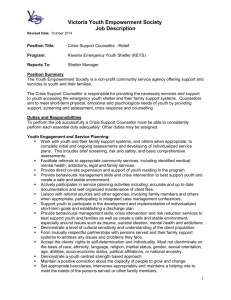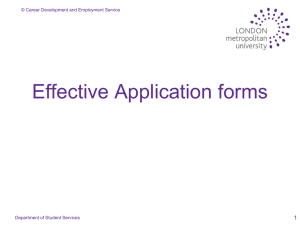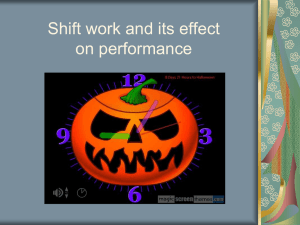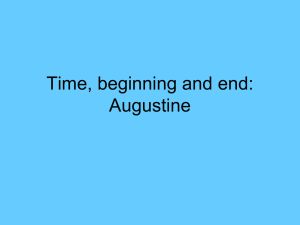Developing Systems Thinking Competencies Through Facilitated
advertisement
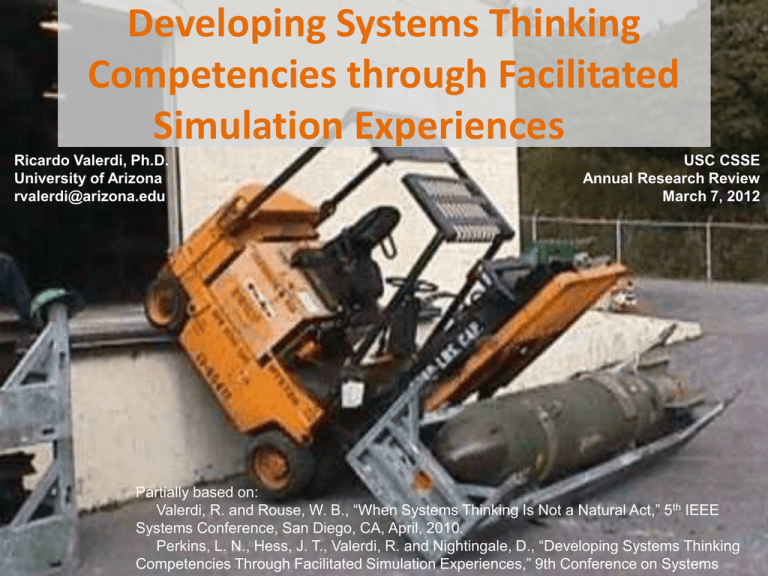
Developing Systems Thinking Competencies through Facilitated Simulation Experiences Ricardo Valerdi, Ph.D. University of Arizona rvalerdi@arizona.edu USC CSSE Annual Research Review March 7, 2012 Partially based on: Valerdi, R. and Rouse, W. B., “When Systems Thinking Is Not a Natural Act,” 5th IEEE Systems Conference, San Diego, CA, April, 2010. Perkins, L. N., Hess, J. T., Valerdi, R. and Nightingale, D., “Developing Systems Thinking Competencies Through Facilitated Simulation Experiences,” 9th Conference on Systems Theory is when you know everything, but nothing works. Practice is when everything works, but no one knows why. This is where theory and practice come together... Nothing works and no one knows why. - on the door of a laboratory at MIT 2 Four Things You Should Know About Systems Thinking 1. Systems thinking is not a natural act 2. Western educational system is the biggest inhibitor to systems thinking 3. Systems thinking can be taught (but not to everyone, unfortunately) 4. The best way to develop your systems thinking abilities is through experiential learning 3 Inspiration The Seven Secrets of How to Think Like A Rocket Scientist (Longuski 2010) How to Think Like Leonardo da Vinci (Gelb 1998) Secret #2: Work on the big picture “Think of the end before the beginning” 4 Systems Thinking Competencies 1. Ability to define the “universe” appropriately – the system operates in this universe 2. Ability to define the overall system appropriately – defining the right boundaries 3. Ability to see relationships – within the system and between the system and universe 4. Ability to see things holistically – within and across relationships 5. Ability to understand complexity – how relationships yield uncertain, dynamic, nonlinear states and situations 6. Ability to communicate across disciplines – to bring multiple perspectives to bear 7. Ability to take advantage of a broad range of concepts, principles, models, methods and tools – because any one view is inevitably wrong 5 Systems Thinking “Utilizing modal elements to consider the componential, relational, contextual, and dynamic elements of the system of interest.” Davidz, H. L. and Nightingale, D. J. “Enabling Systems Thinking To Accelerate the Development of Senior Systems Engineers,” Systems Engineering, Vol. 11, No. 1, 2008. 6 4/8/2015 7 “Maybe pushing on that wall to the right will give some space.” 8 “Oops!” 9 Systems Thinking: A Latent Construct • Five learning disciplines (Senge 1990) – Personal mastery, mental models, shared vision, team learning and systems thinking • Seven critical skills of systems thinking (Richmond 1993) – Dynamic, closed-loop, generic, structural, operational, continuum, and scientific • Thirty systems thinking laws (Frank 2000) – Synergy, gradual process, life-cycle thinking, solution exploration, etc. • Four foundations of systems methodology (Gharajedaghi 2006) – Holistic thinking, operational thinking, systems theories and interactive design 10 Measures of Systems Thinking • Aptitude tests (Toshima 1993) • Changes in mental models (Doyle, et al. 2008) • Performance on management flight simulators (Sweeney & Sterman 2000) • Application of knowledge, skills and behaviors in the classroom (Frank 2010) 11 Why is systems thinking not a natural act? • Human evolution has favored mechanisms tuned to dealing with immediate surface features of problems – “programmed” human tendencies • Mechanistic/reductionist approach in decision making – Driven by education • Complexity of the systems overwhelms our cognitive capabilities – Bounded rationality, predictably irrational – Magic number 7, plus or minus two 12 Augustine’s Fifth Law One-tenth of the participants produce over one-third of the output. Increasing the number of participants merely reduces the average output. N. R. Augustine, Augustine’s Laws. Reston, VA: AIAA, 1997. Brooks’ Law Adding people to a late project makes it later Brooks, Frederick P., The Mythical Man-Month, Addison Wesley, 1975. 14 Inhibitors to Systems Thinking • Western educational system – No system thinker left behind • Environment/institutional constraints – Incentives, tradition • Work organization – Over-specialized job function 15 Systems Thinking Interventions Study Huz, et al. (1997) Cavaleri & Sterman (1997) Sweeney & Sterman (2000) Witjes, et al. (2006) Doyle, et al. (2008) Sample population (n); Intervention (time) Mental health professionals in New York (n = 18); System dynamics model building by a group (t = 6 months) Systems thinking measure(s) (1) Participants’ perceptions of the intervention, (2) Shifts in participants’ goal structure, (3) Shifts in participants ’ change strategies, (4) Alignment of participant mental models, (5) Shifts in understanding how the system functions, (6) Shifts in network of agencies that support services integration, (7) Changes in system-wide policies and procedures, and (8) Changes in outcomes for clients. Insurance claims professionals (1) changes in personal perceptions, (2) changes in behavior, (n = 70); Beer Game (t = not reported) and (3) competency in understanding the principles of the Beer Game University students (n = 225); Bath (1) feedback, (2) delays, and (3) stocks and flows. tub and cash flow exercises (t = 2 weeks) 7-10 year old children in rural Interpretation of drawings in terms of three systems thinking Colombia (n = 22); construction of a levels: (1) systems, subsystems and synergy, (2) rain water recollection system and possessiveness and feedback, and (3) chaos and order. organic vegetable garden (t = 5 months) University students (n = 46); changes in (1) mental models and (2) feedback thinking Simulation of the economic long wave model (t = 2 weeks) 16 Mental Models in Rural Colombia Sjors Witjes, Pablo Muñoz Specht, Carolina Montoya Rodríguez, The Measurement of the Development of Systems and General Thinking in Agricultural Areas of Colombia: Preliminary Results, Los Andes University. 17 A Glimmer of Hope from Religion & Education • Buddhism – Systems view as a systems experience – Appropriate level of analysis for any problem – Cause and effect (karma) – Cycles and continuous flowing (Sangsara) – Constant flux due to external conditions (Annica) • Scientific Habits of Mind – Systems based reasoning – Model based reasoning – Understanding feedback 18 Behavior Over Time Graphs • Focus on patterns of change over time rather than on isolated events, leading to rich discussions on how and why something is changing 19 Experience Accelerators • Management Flight Simulator http://scripts.mit.edu/~jsterman/climate/master/ 20 Healthcare Reborn (http://www.healthcarereborn.com) Tied for 1st place in Stevens Institute of Technology Experience Accelerator Competition (www.experience-accelerator.org) 21 Player understanding of Systems Thinking Concepts Statistically Significant (p < 0.05) 22 Stealth Data for Healthcare Reborn n=20 # of Doctors used per level n=20 Avg. Patient Satisfaction Shute, V. J., Masduki, I. and Donmez, O. 2010. Conceptual Framework for Modeling, Assessing and Supporting Competencies within Game Environments. Technology, Instruction, Cognition, and Learning 8, no. 2: 137-161. Four Things You Should Know About Systems Thinking 1. Systems thinking is not a natural act 2. Western educational system is the biggest inhibitor to systems thinking 3. Systems thinking can be taught (but not to everyone, unfortunately) 4. The best way to develop your systems thinking abilities is through experiential learning 24 25




